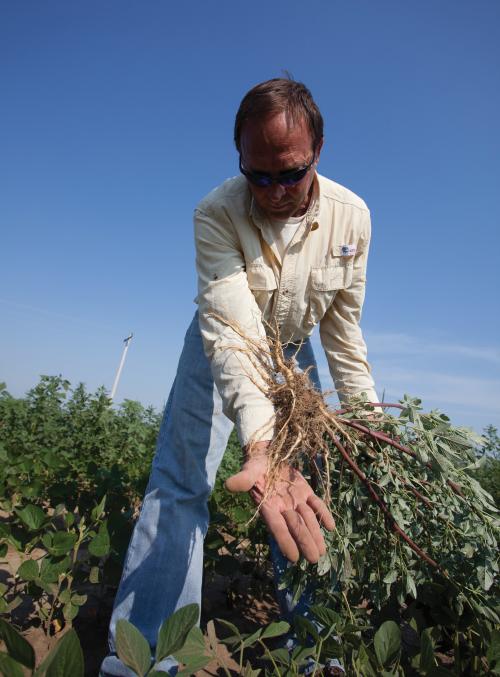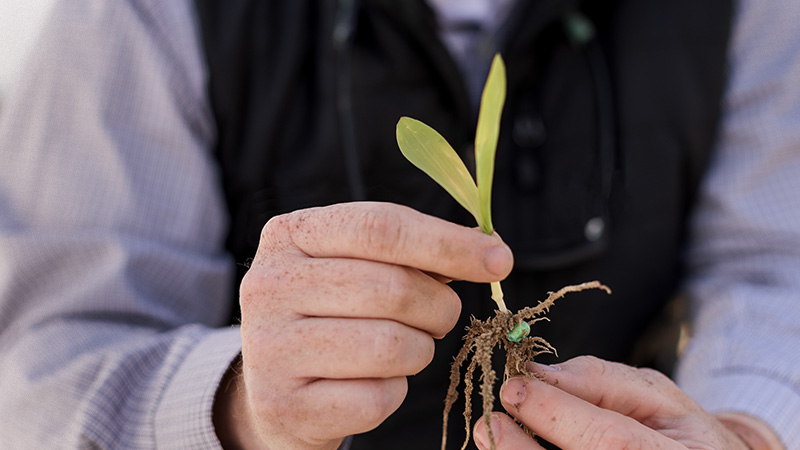Historic Prevent Planting in 2019 Requires a Solid Weed Control Plan This Year
Since the early 2000s, when the first glyphosate-resistant marestail was confirmed in a Delaware crop field, herbicide-resistant weeds have continued to relentlessly march across the rest of the globe. In fact, according to the International Herbicide-Resistant Weed Database, there are currently 512 unique cases of herbicide resistant weeds around the world, represented by 262 separate species. In total, these weeds have developed resistance to 23 of the 26 known herbicide modes of action, which impacts more than 160 different herbicides.
In the U.S., growers are doing their best to combat several “hardy” weed types such as waterhemp and Palmer amaranth – both of which now typically exhibit three-way resistance to ALS inhibitors, glyphosate, and atrazine (waterhemp) and ALS inhibitors, glyphosate, and PPOs (Palmer amaranth).

Arkansas Grower Malcolm Haigwood shows just how big glyphosate-resistant pigweed can get once established in the field.
In fact, says Darren Unland, Technical Marketing Manager for BASF Corp., there are currently 50 million acres of U.S. cropland infested with herbicide-resistant waterhemp and 45 million acres containing herbicide-resistant Palmer amaranth. “This translates into U.S. growers spending 3.8 times more on herbicides in recent growing seasons than they previously did,” says Unland. “That’s why our company has focused on helping growers across the country on eradicating these and other resistant pigweed species through the Operation Weed Eradication program.”
The Effects of 2019
And this and other similar herbicide-resistant weed control efforts will become much more important this year, Unland predicts, after the kind of year 2019 ended up being for agriculture. “Depending upon where you were in the country, 2019 was a difficult year to a horrible year when it came to doing pre-emerge herbicide applications and planting on time,” he says. “A lot of fields ended up never getting planted, so there were probably many herbicide-resistant weeds that were able to reach maturity and go to seed without any interference from the growers.”
“Last year was a very wet one for a lot of the country,” says Tom Mudd, Marketing Manager — Corn & Soybean Herbicides for UPL NA Inc., while discussing water-laden fields in 2019. “It was hard for growers and applicators to get herbicides down at all. This led directly to the prevent plant numbers we saw.”
According to the Farm Bureau and USDA estimates, more than 19 million acres of farmland ended up in this “prevent plant” situation during the 2019 growing season. And the spillover from this will reach far into the 2020 growing season, says Nathanial Quinn, Marketing Manager for Corn, Soybeans, and Sugar Beets for AMVAC Chemical Corp. “The number of prevent plant acres in 2019 was not only significant, it was historic,” says Quinn. “Right now, the expectation is that a large percentage of these acres will go back into production for 2020, but the weed spectrum present in them might be particularly bad since many seed banks were allowed to germinate, unlike during previous growing years.”
Of course, says Travis Gustafson, a Crop Protection Agronomist for Syngenta Crop Protection, the planned “reclamation project” by growers on prevent plant ground might not be that easy. “The prevent plant acres from last year will really need to have serious maintenance done on them to get back into production for 2020,” says Gustafson. “In fact, it might take two or three years to get back the kind of weed control on this land that growers had back during 2018 and beforehand.”
The Outlook for 2020
According to BASF’s Unland, the best advice U.S. growers can follow to fight the spread of herbicide-resistant weeds in their fields is to plan accordingly. “In 2020, the best recommendation I can make is to have a solid plan in place for handling weed control, to not skimp on pre-emergent herbicides, and do at least two post-emergent applications,” he says. “Given what happened during 2019, ag retailers and their grower-customers should expect that there will be a lot of herbicide-resistant weeds out there to fight.”
Kenneth Barham, Vice President Customer & Brand Marketing for Nufarm Americas Inc., also agrees with these market assessments. “Because of the wet weather and prevent plant acres, many growers missed their burndown applications in 2019, both in the spring and during the fall,” says Barham. “That means there’s a much bigger seed bank out there than the market has ever seen. And if growers miss with their weed control again in 2020, you are going to see some serious in-crop battles taking place with weeds that will be near impossible to manage.”
To aid in this effort, Barham points to Nufarm’s Panther SC herbicide as a possible weed control tool. Featuring the active ingredient flumioxazin, Panther SC is a pre-emerge PPO inhibitor for use in soybeans, cotton, and peanuts. “It can control a broad spectrum of broadleaf and grass weeds, including most broadleaf weeds resistant to glyphosate,” he says. “Panther SC also offers long-lasting residual control to help keep fields clean.”
According to Gail Stratman, Regional Technical Service Manager — Heartland for FMC Corp., having an effective pre-emergence weed control program will be key to weed control success during the 2020 growing season. “Employing different modes of action will be important, because otherwise, the market risks making the resistant weed problem worse than it’s been for many, many years,” says Stratman.
For this reason, FMC has introduced Authority Edge herbicide for the 2020 growing season. A new preplant and pre-emergence herbicide, Authority Edge features a formulation combining pyroxasulfone and sulfentrazone that can be used to control ALS, triazine, HPPD, glyphosate, and PPO herbicide resistant weed biotypes such as waterhemp, Palmer amaranth, pigweed, and common lambsquarters.
Another new entry in the pre-emerge segment for soybeans in 2020 is Antares Complete from Helena Agri-Enterprises, LLC. A combination of sulfentrazone, s-metolachlor, and metribuzin, Antares Complete can be used to control a variety of broadleaf weeds and grasses, says Mark Wayland, Manager of Herbicide Brands. “We’re in a battle with broadleaf and grassy weeds at the beginning of every growing season,” says Wayland. “If we don’t get out there and manage those weeds early, they can get the upper hand and challenge our corn and soybeans for the light, water, nutrients, and ground they need to grow and thrive.”
In addition, Helena has announced another new herbicide, this one to be introduced in time for the 2021 growing season. Called Empyros, it is a broad-use pre- and early post-emergence product for use in corn featuring two active ingredients — s-metolachlor and topyralate, the newest HPPD inhibitor for the U.S. marketplace.
In the post-emergence segment, Valent U.S.A. Corp. has introduced Perpetuo herbicide for 2020. A combination of flumiclorac and pyroxasulfone, Perpetuo offers burndown and residual control of broadleaf weeds and grasses and can be used in conjunction with any soybean or corn trait system, says Dr. John Pawlak, Product Development Manager.
“Weeds such as waterhemp and Palmer amaranth have long germination windows that can last through late summer, making them hard to control with a single pre-emergence application,” says Pawlak. “An average Palmer amaranth plant can produce more than 500,000 seeds in a season, so 2020, following the unevenness of weed kills in 2019, could be a terrible year in this respect without a good control program in place.”
Recently, AMVAC announced that it had significantly expanded its product portfolio when it comes to herbicides. In December, the company purchased four herbicides from Corteva – Classic (chlorimuron ethyl) and FirstRate (cloransulam-methyl) for soybeans, Hornet (clopyralid potassium salt+flumetsulam) for field corn, and Python (flumetsulam) for both crops.
A Systems Approach
In addition to using new and different herbicides to fight against resistant weeds, ag retailers and their grower-customers have employed a number of new cropping systems into the mix. Since 2017, row crops resistant to dicamba have been planted on an increasing number of acres to control herbicide-resistant weeds. In fact, according to the figures, U.S. growers will plant 50 million acres of cropland containing these varieties in 2020, equivalent to 66% of America’s crop in 2019. As result, several crop protection suppliers have products to apply to these crops, including XTendiMax from Bayer, FeXapan from Corteva, and Engenia from BASF.
In April, another such herbicide was added to the mix — Tavium with VaporGrip technology from Syngenta. A blend of s-metolachlor and dicamba, Tavium can be used for preplant, at planting, and early post-emergence on Roundup Ready 2 Xtend soybeans and Bollgard II XtendFlex cotton to control such weeds as waterhemp, Palmer amaranth, marestail, morning glory, and common and giant ragweed. And according to Bobby Bachman, Herbicide Product Lead, Tavium certainly helped during last year’s growing season.
“If there was ever a season that put weed control to the test, 2019 would be it,” says Bachman. “The harvest delays … are similar to last year’s, and once again, we won’t have much time to spray burndown applications. This means 2020’s pre-emergence and early post-emergence application choices are all the more important.”
For the 2020 growing season, however, the agricultural marketplace should see an increase in the number of crop acres planted with a different type of herbicide-tolerant trait present. For a few years now, Corteva has been slowly rolling out its Enlist cropping system, which is tolerant to herbicides containing 2,4-D. And according to Shawna Hubbard, Traits Herbicide Product Manager, the company is projecting that its E3 soybeans will be planted on approximately 20% of U.S. acres in 2020 — double Corteva’s earlier estimate from fall 2019.
“This is the biggest new tool growers will have in 2020 to combat herbicide-resistant weeds,” says Hubbard. “E3 soybeans have tolerance to three different herbicides — 2,4-D choline such as Enlist One, glyphosate, and glufosinate such as Liberty. This will allow users to design an effective post program with different pass and tank mix options. This, in turn, should help keep the fields free of troublesome weeds.”
Speaking of glufosinate, Hubbard adds that Corteva has formally partnered with BASF to recommend applicators use both Enlist One and Liberty on E3 soybeans. “The combination of Enlist One plus Liberty herbicide is lights out on tough pigweed and waterhemp,” she says. “Using both products post-emergence will help farmers get the cleanest fields they’ve seen in years in areas infested with tough weeds. That’s why Liberty herbicide is now Corteva’s recommended glufosinate for use with the Enlist weed control system.”
Growers looking for more such cropping system options will soon likely see another new entry — XtendFlex soybeans from Bayer. According to Megan McQuoid, Soybean Traits Marketing Manager, XtendFlex soybeans will be triple stacked to have tolerance to glyphosate, glufosinate, and dicamba, offering control of such weeds as waterhemp, Palmer amaranth, and marestail. “Hopefully, if all the regulatory approvals go as planned, XtendFlex soybeans will be available for the 2021 growing season,” says McQuoid.






